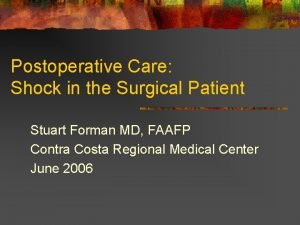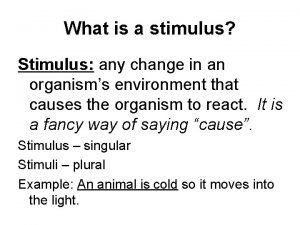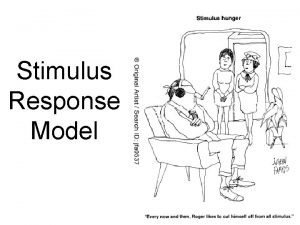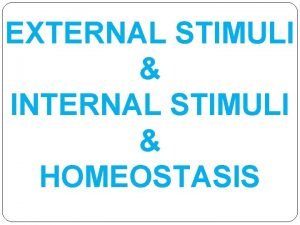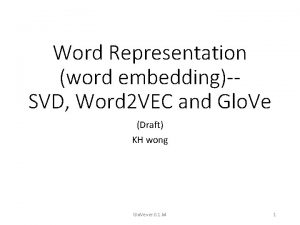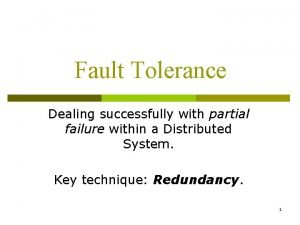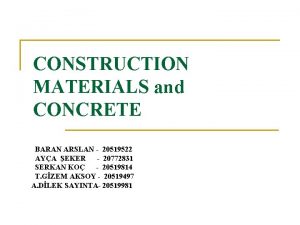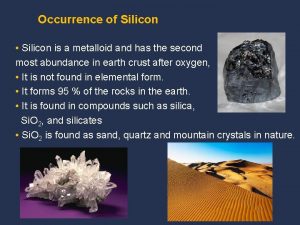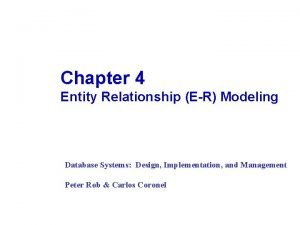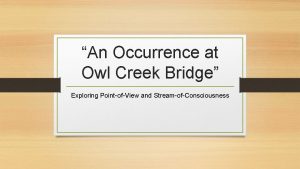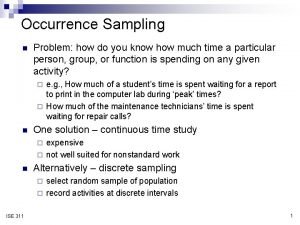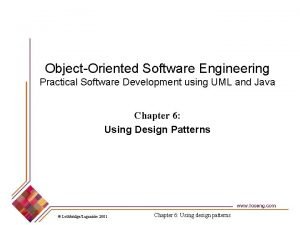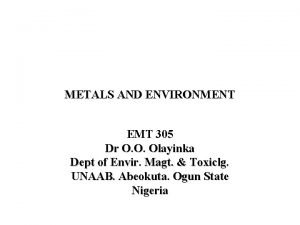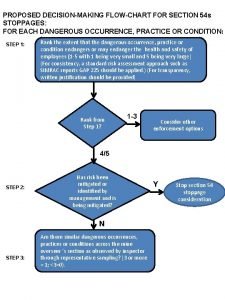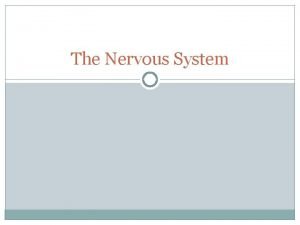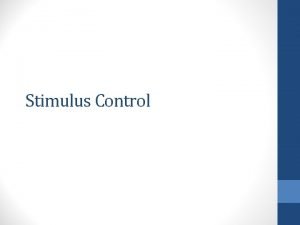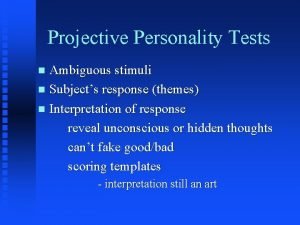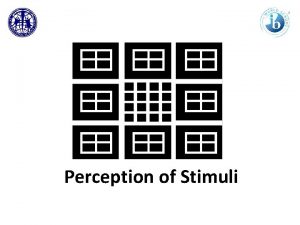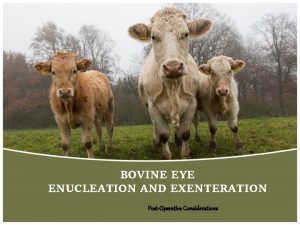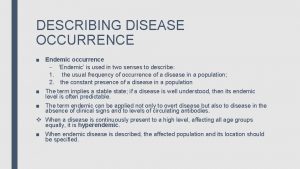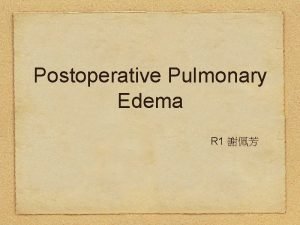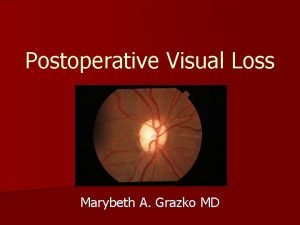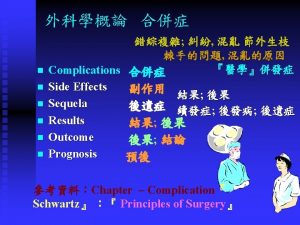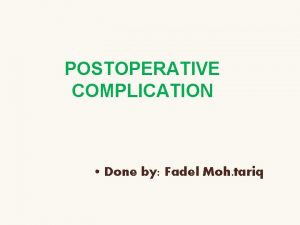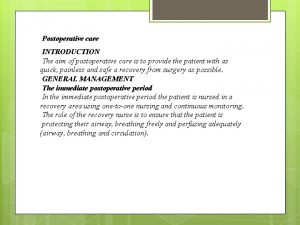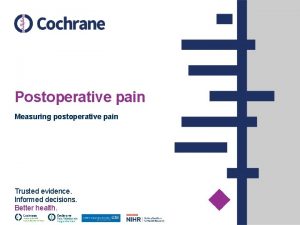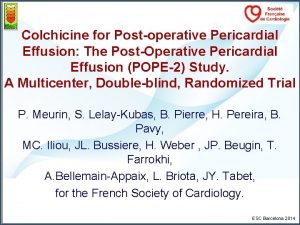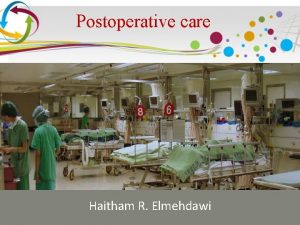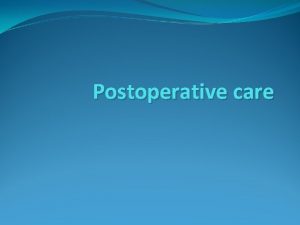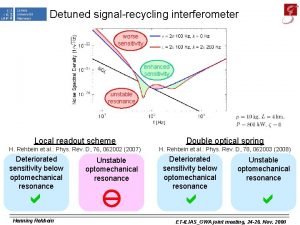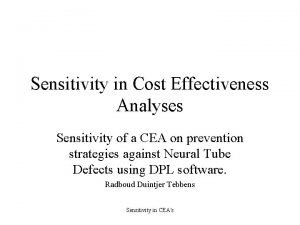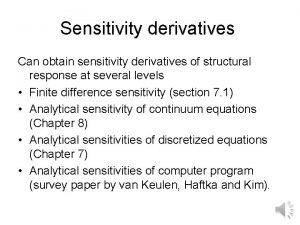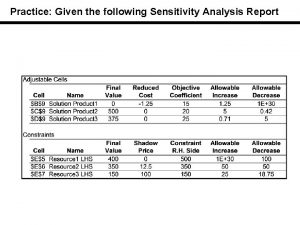Occurrence and Causing Stimuli of Postoperative Sensitivity in




































- Slides: 36

Occurrence and Causing Stimuli of Postoperative Sensitivity in Composite Restorations TM Auschill • CA Koch • M Wolkewitz • E Hellwig • NB Arweiler (2009)

INTRODUCTION Over the past decade, the use of resin-based dental composite fillings has increased significantly. With the development of improved adhesive and composite systems

INTRODUCTION Despite these improvements in materials and techniques, postoperative sensitivity following composite restoration still remains a problem, especially in posterior teeth. A standard view regarding the treatment of this complication does not exist.

INTRODUCTION Clinicians still have to rely on their subjective judgment when deciding whether to monitor, modify or replace the restoration. Therefore, this prospective clinical study evaluated the rate of postoperative sensitivity, any possible risk factors or causative stimuli and types of sensitivity as described by the patient.

METHODS AND MATERIALS

METHODS AND MATERIALS 600 teeth in 231 patients (137 men and 94 women, ages 18 to 71 years) requiring composite restorations were selected for the study. All treatments were performed by fourth- or fifth-year dental students working under the close supervision of four staff members of the Department of Operative dentistry and Periodontology.

METHODS AND MATERIALS Inclusion criteria : 1. Composite restoration in an anterior or posterior tooth. 2. All restored teeth were required to be vital. Exclusion criteria : 1. Allergies against the composite materials used. 2. Participation in another clinical study. 3. Negative reaction of the chosen tooth to the vitality test. 4. Presence of any tooth sensitivity or pain prior to the restoration.

METHODS AND MATERIALS First, the patient decided whether or not he or she preferred local anesthesia. Shade selection and the teeth were isolated with a rubber dam or cotton rolls. Removal of any previous restoration material or the first opening of the cavity in the case of primary caries. All cavities were beveled and, when necessary, an appropriate matrix was placed and fixed with wooden wedges.

METHODS AND MATERIALS Etched with a 37. 5% phosphoric acid gel. Dentin primer and bonding agents were applied. (Optibond FL, Kerr. Hawe) For the actual restorative procedure, a nanofilled composite (Ceram X, Dentsply De. Trey, Konstanz, Germany) All restorations were finished. Checked with articulating paper and the proximal contacts were assessed. Approximately two weeks later, the restorations were high-gloss polished with a Hawe Occlubrush.

METHODS AND MATERIALS During treatment, the operator noted: 1. The use of anesthesia (yes, no) 2. The use of a rubber dam (yes, no) 3. The reason for the restoration treatment (caries, restoration replacement, other) 4. The cavity class (I, III, IV, V) 5. The clinical dimensions of the cavity (enamel, dentin, caries profunda [inner third of dentin], pulp exposure)

METHODS AND MATERIALS Each restoration was evaluated clinically after about two weeks (visit 2) during the polishing session and was assessed for postoperative sensitivity. The patients were asked to give a score on a 10 point- scale, with 10 meaning “maximal sensitivity”.

METHODS AND MATERIALS The patients were asked to quantify the following details of their sensitivity with the same visual scale from 0 to 10. In addition, the operator tested : The vitality of the tooth (positive, negative) by using a coolant spray. The absence or presence of postoperative pain to masticatory forces (tested with a cotton roll) (yes, no).

METHODS AND MATERIALS For the statistical analysis, “failure” of the restoration regarding postoperative sensitivity was defined (visit 2) as: Negative reaction to the vitality test at the polishing appointment. Postoperative pain to masticatory forces at the polishing appointment. Reported postoperative sensitivity by the patient (score >0).

METHODS AND MATERIALS The risk of postoperative sensitivity was statistically analyzed by comparing different parameters : Age and gender of the patient The reason for the restoration treatment The clinical dimension of the cavity The cavity class The use of a rubber dam The use of local anesthesia.

RESULTS

RESULTS

RESULTS All patients returned to the polishing and evaluation appointment after about 2 weeks. 94% of restoration did not show any of the defined failure criteria. 6% a failure of the restoration was observed.

Table 1

Table 2

Table 3

RESULTS The clinical class of the filling , the use of anesthesia or the use of a rubber dam was no significant effect on postoperative sensitivity. Cavity depth was significantly associated with the appearance of postoperative sensitivity.

DISCUSSION

DISCUSSION Theory about transmission of pain Theory 1 : Dentinal tubule has nerve running along entry tubule. Theory 2 : Odontoblastic process Serve as receptor. Theory 3 : Hydrodynamic theory Fluid movement within the dentinal tubule cause by drying, heating, chemical agent, bacteria, Polymerization shrinkage, Occlusal stress.

DISCUSSION Dentine adhesive Bond tooth structure and restoration. Obliterate dentinal tubule Prevent invasion of Bacteria and outer stimuli. However acid etching has been related to Post-op problem such as - tooth sensitivity - pulp inflammation

DISCUSSION Polymerization shrinkage can also provoke gap forming between resin and hybridge layer. In current study Failure rate 6% compared to other study failure rate up to 30%. Optibond FL 3 step etch and rinse bonding system shows best clinical performance.

DISCUSSION Subjective assessment Sensitivity using Visual analogue scale Causing stimuli Objective assessment Vitality test Level of discomfort on loading

DISCUSSION Gordan and others “Sensitivity stimuli included cold, heat, chewing and spontaneous sensitivity” Kuijs and others “asked patients under what circumstances (cold/warm, while biting, spontaneously) they had experienced sensitivity” Sobral and others “Asked patients to record sensitivity triggered by stimuli”

DISCUSSION Risk factors for postoperative sensitivity v Anesthesia use v Rubber dam use v The reason for restorative treatment v Clinical class of the restorations v Clinical cavity depth

DISCUSSION v Use of Anesthesia and Rubber dam No significant influence on postoperative sensitivity Rubber dam use : a trend towards a protective effect against failure was noted.

DISCUSSION v Reason for Restorative Treatment no significant difference between replacement restorations and treatment of primary caries. Baratieri and Ritter reported that replacement restorations induced more postoperative sensitivity (86%) than those placed because of primary decay (14%).

DISCUSSION v Clinical Class of the Restorations Several factors may be responsible for postoperative sensitivity in posterior composite restorations, such as Polymerization shrinkage Bulk filling technique Incomplete coating of the dentin surface with dentin adhesives Traumatic occlusion.

DISCUSSION v Clinical Class of the Restorations Feilzer and others 34 showed that the C-factor is greater than five, thereby producing higher concentration stress, because only one of the current six surfaces is free. Concerning the C -factor, Class IV restorations are supposed to show the least polymerization stress, whereas the current study could not support this finding.

DISCUSSION v Clinical Class of the Restorations The current results did not show a significant association of postoperative sensitivity to specific clinical classes. The etching procedure and polymerization shrinkage in composite restorations lead to postoperative sensitivity.

DISCUSSION v Cavity Depth The deeper the cavity, the wider the dentinal tubules that could explain why deeper cavities had more reports of postoperative sensitivity and pain.

CONCLUSION The current study detected individual factors that may lead to postoperative sensitivity in order to enable clinicians to define an individual risk of failure for each case. No significant effect on sensitivity was seen based on the reason for the restoration, the clinical class of the filling, the use of anesthesia or the use of a rubber dam. Cavity depth was significantly associated with the appearance of postoperative sensitivity.

 Nanda nursing diagnosis for cataract
Nanda nursing diagnosis for cataract Post operative nursing care
Post operative nursing care Data klinis
Data klinis Postoperative shock
Postoperative shock External stimulus
External stimulus Stimulus response model
Stimulus response model Difference between internal and external stimuli
Difference between internal and external stimuli Humoral neural and hormonal stimuli
Humoral neural and hormonal stimuli The bone is bent and splits causing an incomplete break.
The bone is bent and splits causing an incomplete break. Co occurrence matrix example
Co occurrence matrix example Animal texture
Animal texture Partial failure
Partial failure Gypsum occurrence
Gypsum occurrence Occurrence verbs
Occurrence verbs Occurrence of silicon
Occurrence of silicon Catastrophe modeling
Catastrophe modeling Multivalued attribute example
Multivalued attribute example Examples of irony in an occurrence at owl creek bridge
Examples of irony in an occurrence at owl creek bridge An occurrence at owl creek bridge pov
An occurrence at owl creek bridge pov Foreshadowing in owl creek bridge
Foreshadowing in owl creek bridge What is the climax of an occurrence at owl creek bridge
What is the climax of an occurrence at owl creek bridge It is an occurrence of harmony
It is an occurrence of harmony Occurrence sampling
Occurrence sampling The recurring aspects of designs are called design
The recurring aspects of designs are called design Occurrence of zinc
Occurrence of zinc Dangerous occurrence
Dangerous occurrence Come to occurrence
Come to occurrence An occurrence at owl creek bridge comprehension questions
An occurrence at owl creek bridge comprehension questions What is stimuli in nervous system
What is stimuli in nervous system Responding to internal stimuli
Responding to internal stimuli Define stimulus
Define stimulus How animals respond to stimuli
How animals respond to stimuli Example of middle range theory
Example of middle range theory Forced choice preference assessment data sheet
Forced choice preference assessment data sheet Tests that present ambiguous stimuli
Tests that present ambiguous stimuli Projective hypothesis
Projective hypothesis Noxious stimulation
Noxious stimulation



